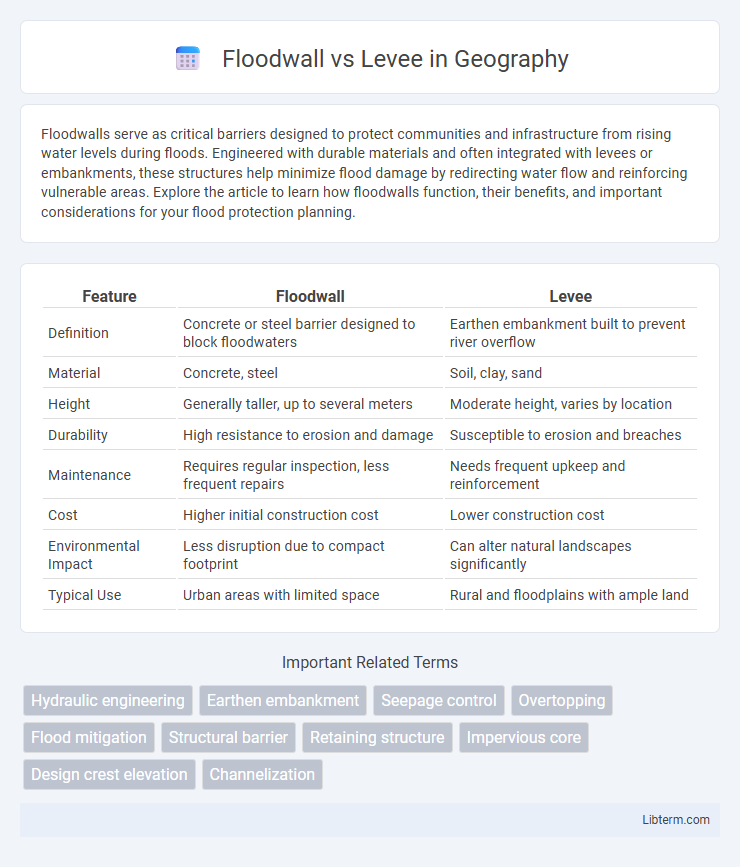Floodwalls serve as critical barriers designed to protect communities and infrastructure from rising water levels during floods. Engineered with durable materials and often integrated with levees or embankments, these structures help minimize flood damage by redirecting water flow and reinforcing vulnerable areas. Explore the article to learn how floodwalls function, their benefits, and important considerations for your flood protection planning.
Table of Comparison
| Feature | Floodwall | Levee |
|---|---|---|
| Definition | Concrete or steel barrier designed to block floodwaters | Earthen embankment built to prevent river overflow |
| Material | Concrete, steel | Soil, clay, sand |
| Height | Generally taller, up to several meters | Moderate height, varies by location |
| Durability | High resistance to erosion and damage | Susceptible to erosion and breaches |
| Maintenance | Requires regular inspection, less frequent repairs | Needs frequent upkeep and reinforcement |
| Cost | Higher initial construction cost | Lower construction cost |
| Environmental Impact | Less disruption due to compact footprint | Can alter natural landscapes significantly |
| Typical Use | Urban areas with limited space | Rural and floodplains with ample land |
Overview: Floodwall vs Levee
Floodwalls are engineered vertical structures, typically made of concrete or steel, designed to provide localized protection against rising floodwaters in urban areas. Levees are earthen embankments constructed from compacted soil that extend over long distances to prevent river or coastal flooding across wide floodplains. Both structures aim to mitigate flood risks but differ in materials, design, and application depending on the terrain and flood hazard severity.
Definitions and Core Concepts
A floodwall is a vertical barrier usually made of reinforced concrete designed to prevent floodwaters from inundating specific areas, often used in urban settings with limited space. A levee is an earthen embankment or ridge constructed along rivers or coastlines to contain rising water and protect large land areas from flooding. Both structures serve as critical components of flood risk management, but floodwalls prioritize durability and urban adaptability, while levees emphasize large-scale water containment using natural materials.
Structural Differences
Floodwalls are engineered vertical barriers made from reinforced concrete or steel designed to prevent floodwaters from encroaching on protected areas, typically featuring a slim profile and greater height capacity. Levees are earthen embankments constructed from compacted soil or rock, characterized by a broad base and gentle slope that dissipate water force over a larger area. The primary structural difference lies in floodwalls' rigidity and verticality versus levees' mass and incline, affecting installation feasibility and flood defense efficiency.
Materials Used in Construction
Floodwalls are typically constructed from reinforced concrete, steel, or modular panel systems designed to provide a durable, rigid barrier against high water levels. Levees primarily consist of compacted earth, clay, sand, or rock, using natural materials that are shaped and layered to form an embankment as a flood protection measure. The choice of materials directly impacts the structure's strength, flexibility, and suitability for different flood scenarios in flood management systems.
Effectiveness in Flood Protection
Floodwalls provide superior effectiveness in urban flood protection due to their ability to be constructed vertically, requiring less land space compared to levees, which are wide, earthen embankments that demand significant land area. Floodwalls are typically made of concrete or steel, offering higher durability and resistance against high water pressure, while levees are more susceptible to erosion and breach during extreme flood events. Both structures require regular maintenance, but floodwalls generally offer more reliable and long-term flood defense in densely populated or infrastructure-sensitive areas.
Cost Comparison: Floodwalls and Levees
Floodwalls typically incur higher construction and maintenance costs than levees due to their engineered concrete or steel structures designed for urban settings. Levees, primarily composed of earth materials such as soil and rock, offer a more cost-effective solution for flood protection over expansive rural areas. Evaluating long-term expenses includes factors like durability, required land use, and potential environmental impacts, which often make levees preferable for budget-conscious flood mitigation projects.
Maintenance and Longevity
Floodwalls, typically constructed from concrete or steel, require regular inspection and maintenance to address cracking, corrosion, and joint deterioration, ensuring long-term structural integrity. Levees, made from compacted earth, demand careful vegetation control, erosion prevention, and periodic strengthening to maintain their height and stability over time. Proper upkeep of both floodwalls and levees significantly extends their longevity, reducing the risk of failure during high-water events.
Environmental Impact
Floodwalls typically have a smaller environmental footprint compared to levees, as they occupy less land and preserve natural habitats by being narrow, vertical barriers. Levees often require large-scale earthworks, leading to significant alteration of riverbanks, disruption of ecosystems, and loss of wetlands that serve as crucial wildlife habitats and natural flood buffers. Both structures impact water flow and sediment transport, but levees more profoundly affect floodplain connectivity and biodiversity due to their extensive footprint.
Ideal Scenarios for Each Structure
Floodwalls are ideal in urban areas with limited space, where vertical barriers can protect infrastructure without requiring wide land use. Levees suit rural or agricultural regions, providing extensive horizontal barriers along rivers or coastlines to contain floodwaters over large areas. Combining both structures may optimize protection when terrain and urban density vary significantly.
Case Studies and Real-World Examples
Floodwalls and levees have been widely studied through major case studies such as the Mississippi River Flood of 1927, where levees failed catastrophically, highlighting their vulnerability to overtopping and erosion. In contrast, floodwalls proved effective during Hurricane Harvey in Houston, providing targeted, reinforced barriers that minimized flood damage in urban areas. Real-world examples demonstrate that combining levees with floodwalls, as seen in the Netherlands' Delta Works project, enhances flood protection by leveraging the strengths of both structures in diverse environments.
Floodwall Infographic

 libterm.com
libterm.com